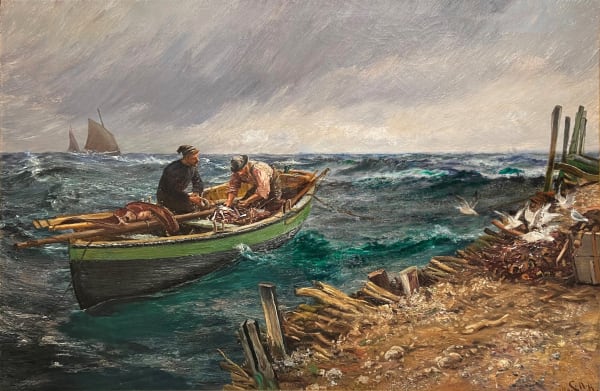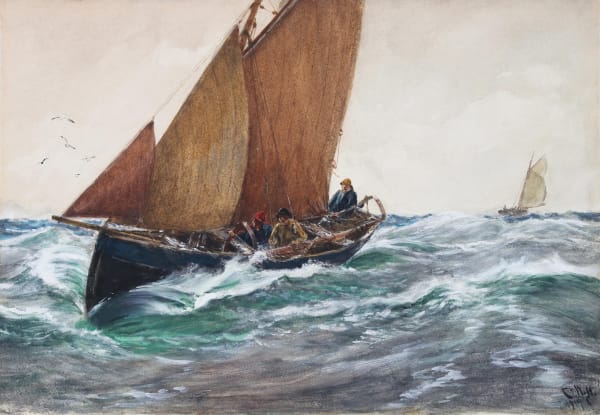Charles Napier Hemy 1841-1917
-
 Charles Napier HemyOn a Wind, 1911Tempera & watercolour on paper laid to canvas60.2 x 90.7 cm (23.7 x 35.7 ins.)
Charles Napier HemyOn a Wind, 1911Tempera & watercolour on paper laid to canvas60.2 x 90.7 cm (23.7 x 35.7 ins.)
Framed: 72.9 x 103.4 cm (28.7 x 40.7 ins.)View full details -
 Charles Napier HemyCounting the Catch!, 1902Oil on canvas81.9 x 121.9 cm (32 1/4 x 48ins.)Sold
Charles Napier HemyCounting the Catch!, 1902Oil on canvas81.9 x 121.9 cm (32 1/4 x 48ins.)Sold
Framed: 107.3 x 148 cm (42 1/4 x 58 1/4 ins.)View full details -
 Charles Napier HemyThe Little Trawler, 1917Watercolour and tempera on paper laid on board47 x 66 cm (18.5 x 26 ins.)Sold
Charles Napier HemyThe Little Trawler, 1917Watercolour and tempera on paper laid on board47 x 66 cm (18.5 x 26 ins.)Sold
Framed: 65 x 86 cm (25.6 x 33.9 ins.)View full details -
 Charles Napier HemyThe Run Home, 1911Oil on board25.4 x 35.6 cm (10 x 14 ins)Sold
Charles Napier HemyThe Run Home, 1911Oil on board25.4 x 35.6 cm (10 x 14 ins)Sold
Framed: 39 x 49.3 cm (15.6 x 19.4 ins)View full details
"I have built my house here (Falmouth) so as to paint nothing but sea and ships and do them always from nature. It is sad not to be in London but I think Falmouth is better than Venice."
Charles Napier Hemy, regarded the finest marine artist of his generation.
Charles Napier Hemy was the first Falmouth artist to be elected a Royal Academician and was ‘the finest marine artist of his generation’.
Born into a musical family in Newcastle-Upon-Tyne on 24 May 1841, Charles was the eldest of three brothers. Bernard Benedict Hemy (1845–1913) and Thomas Madawaska Hemy (1852–1937) were also painters but did enjoy their elder brother’s success.
In 1850, in financial difficulties, the Hemys emigrated to Australia aboard a ship named the Madawaska, travelling in steerage. Charles’ parents recorded the hope of a new life that this trip represented in the naming of their youngest child, born during the voyage. For the young Charles, the epic voyage and return journey in 1852 were the start of a love affair with boats and the sea: 'It was imprinted on my mind, and I never forgot it'.
In Australia Charles’s father Henry tried his hand at gold prospecting ably assisted by his eldest son. But the move to Australia and Melbourne was not in the end a success. Henry was bush-whacked, and the family found Melbourne tough and lawless. The Hemys booked transit back to England in 1852 with the little bit of gold that Charles and his father had prospected and with what remained, settled the debts that they had fled 2 years earlier.
Upon their return to England, Charles enrolled in Newcastle's Government School of Design under the tutelage of William Bell Scott. The boy’s artistic endeavours were encouraged by his uncle, Isaac Henzell, whose influence was later noted in some marine paintings. Charles also had two stints sailing on merchant vessels in his teenage years which strengthened the young man’s growing affiliation with boats and the ocean. Throughout his life Hemy was also a deeply spiritual man and devout Catholic. From 1860 to 1862 he lived as a Dominican Priest in monasteries in Lyon and Carpentras but ultimately did not find his vocation within the brotherhood. In 1863 the aspiring young artist went to study with the Belgian painter Baron Henri Leys, attending the Antwerp Academy. Heys was much admired by Pre-Raphaelites. Rosetti called him ‘the greatest painter of the century’ (ref. ‘Master of the Sea’, Margaret Powell). At the age of 25, in 1866 Charles married his first wife, Mary Ann Lloyd. Shortly after he went to Hey’s atelier where the Belgian master sent him to the boy’s class to relearn the human form; he continued with life classes for 18 months and the fruits of his labour are evident in his mature work . In 1869 Hemy returned to London where he remained until 1880, working from a gallery studio in Fulham close to the home of Edward Burne-Jones and William Morris’s Workshop, where he also worked for a period. Burne-Jones and James Tissot were to become close friends. In London, Whistler also had a strong impact upon Hemy’s work evident in his paintings of the Thames. Years later in 1904 the Chantry bequest purchased London River for £1000.
By the 1870s Hemy was looking for maritime locations and started to spend his summer months in the fishing harbours of Devon and Cornwall. The Harbour of St Ives (1871) is an early product. As Kenneth McConkey notes in Painting at the Edge, British Coastal Art Colonies, “By the 1870s a new school of marine painters who, emerging from the shadows of Turner and the Pre-Raphaelites, were interested in coastal topography and atmospheres. Each painter had particular haunts. Hemy and others took to the sea, holding up the discomfort of working in storm-tossed conditions as a measure of their truth to nature.”
In 1880 Hemy’s first wife Mary died of meningitis. The couple had borne no children. In 1881 Hemy decided upon a full-time move to Cornwall and chose Falmouth to settle in. He married his second wife, a local Falmouth girl, Amy Freeman, part of the Freeman family who were wealthy Cornish granite merchants. He built Churchfield (now the Athenaeum Club) to his own design and specification and had a boat, the Vanderveld fitted out as a studio. Writing to his friend Luke Fildes he explained: ‘I have built my house here (Falmouth) so as to paint nothing but sea and ships and do them always from nature. It is sad not to be in London but I think Falmouth is better than Venice.’ In Falmouth, Hemy became a mentor to Sir Frank Brangwyn and the renowned marine painter, Montague Dawson. Another friendship that was to last the rest of his life grew with Henry Scott Tuke who having helped found the Newlyn School, moved permanently to Falmouth in 1885. Tuke lived in Pennance Cottage close to Swanpool Beach near Falmouth for the next 44 years and followed his friend’s lead in adopting the idea of a floating studio. Whilst Hemy and Tuke anchored themselves in Falmouth they were very much part of the prospering broader Cornish art scene of the period. “There were great friendships and comings-and-goings between the artists then living in Cornwall. Marriott (Charles Marriott – writer on St Ives art scene), recalled that the marine painters, Henry S. Tuke and Napier Hemy would turn up from Falmouth. Tuke and Hemy were among the elder statesmen of painters working in Cornwall and also the best raconteurs, sharing an immense store of reminiscences.” (David Wilkinson writing in Painting at the Edge, British Coastal Art Colonies, 2005.)
Charles Napier Hemy is renowned for grand, often Royal Academy oil paintings of his favourite maritime subjects but also for watercolour and egg tempera paintings which he could complete in his floating studios and suited his desire to paint from nature and the ever-changing seas. At Churchfield he kept chickens whose eggs provided the yolks for the tempera which give Hemy’s works on paper their vibrancy of colour to the present day and allowed the painter to capture the substance of surf and sea swell. Hemy’s paintings, whether oil or water with egg tempera/ body colour, capture like few other artists have, the relationship between men and the sea. Hemy understood boats and boatmen and braved the often tumultuous seas around the Cornish coast in pursuit of an honest depiction of their struggle. His mature paintings have an incredible sense of movement with the subject boat often slashing through the canvas or exiting the frame altogether. He places us in the centre of the action amid the perilous plunge and rise of boats propelled by ocean swell and rising gale. As Hemy’s granddaughter, Margaret Powell expressed in ‘Master of the Sea’, “By experimenting with broad brushstrokes and developing a catalogue of marks, he conveys in paint one brief moment caught from fleeting time.’
Hemy would undertake a multitude of studies from the Vandervelt and later the Vandermeer before completing major works in his studio at Churchfield. Hemy sold his major works for prices in excess of £1,000. Pilchards was purchased in 1897 for £1,200, equivalent to £157,000 today. With this sort of income, the Hemys and their 10 children enjoyed a very comfortable lifestyle in Churchfield and the house was reputedly furnished in great taste with many beautiful things that Charles had collected and as recounted by Stanhope Forbes after a visit.
Hemy was honoured as an Associate of the Royal Society of Painters in Water Colours in 1890 and became a full member in 1897. In 1898 he was elected an Associate of the Royal Academy and in 1910 a full Academician.
In 1905 John Singer Sargent visited the Hemys at Churchfield and painted a fine portrait of Charles which now resides in the Falmouth Art Gallery. With Amy Mary Freeman, Charles had ten children.
Hemy was sailing and painting right up until the end of his life with 2 works (one of which was The Little Trawler), shown in the Royal Academy Summer Exhibition in 1917. Charles Napier Hemy died in Falmouth on 30 September 1917 and is buried in the Dissenters’ plot in Falmouth Cemetery in the Dominican monk’s habit that he had kept from his early 20s and not far from his friend, Henry Scott Tuke. His tomb is appropriately covered with Cornish Freeman granite.
Falmouth Art Gallery (1991) Charles Napier Hemy Exhibition catalogue
Greg (1984) Charles Napier Hemy RA 1841-1917 (Tyne & Wear County Council Museums, Newcastle Exhibition catalogue)
Powell, Margaret (2004) Master of the Sea: Charles Napier Hemy RA, RWS;, Alison Hodge






